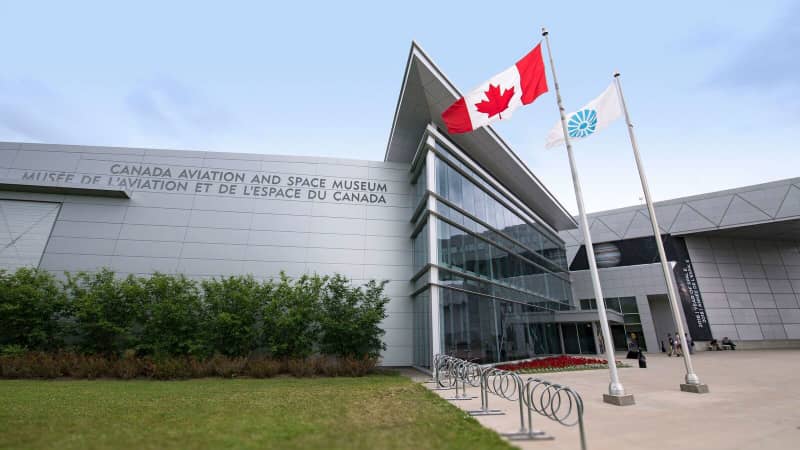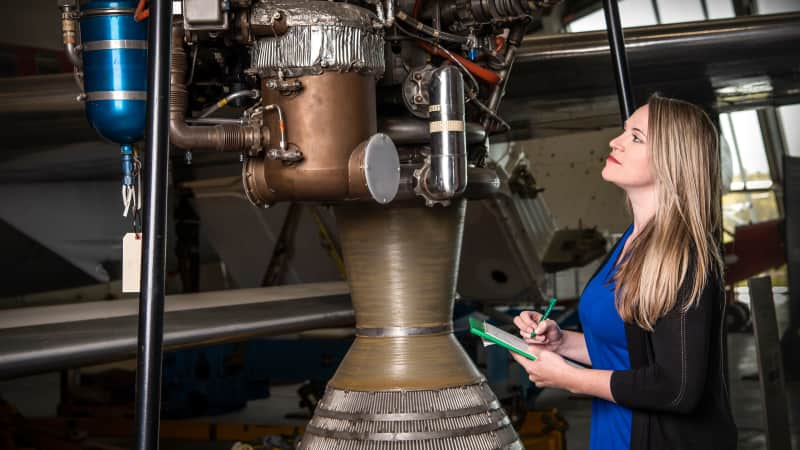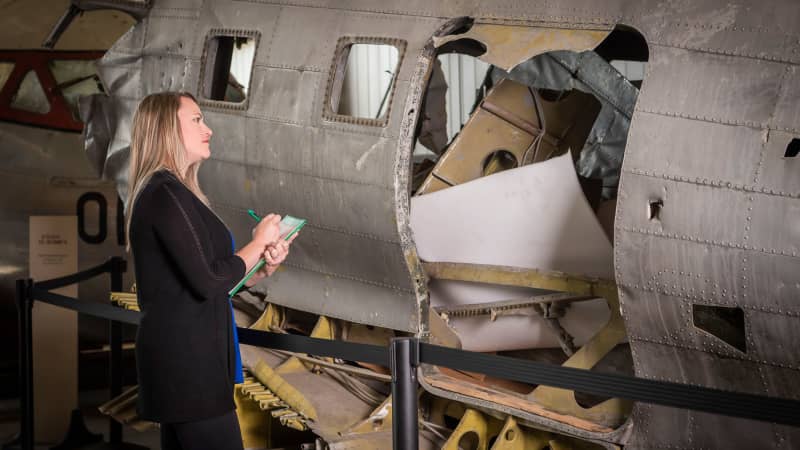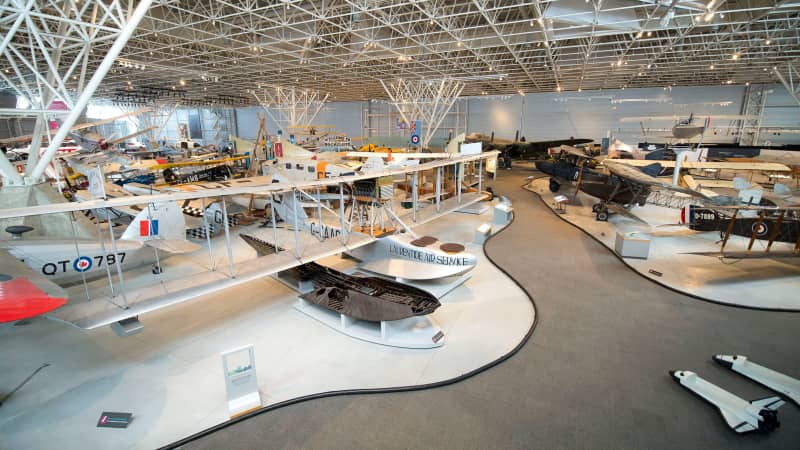Products You May Like
(CNN) — The silent and oppressive hunk of metal in the corner comes alive as Erin Gregory tells its story. The nervousness of the soldiers who climbed aboard the aircraft almost 80 years ago is practically palpable.
While it’s a rare treat for Gregory herself to give tours to the public, her passion for the subject matter and emphasis on storytelling is something she’s passed on to the museum’s tour guides and is evident throughout the space.

The Canadian National Aviation and Space Museum is located in Ottawa, Canada’s capital city.
Courtesy Ingenium
Gregory’s aim is for the museum to spark interest in those who don’t think they care about planes — especially (but not exclusively) women, who often don’t feel like aviation museums are a place for them.
For anyone other than the most dedicated airplane gearhead, aviation museums can be boring. (Sorry to paint an entire category with a single brush, but it’s true.)
Gregory and her team, on the other hand, can paint the picture through stories culled from much education and learning.
“There will always be people who come into the museum because they want to see the machines, and we still have all of that for them,” Gregory says. “But our goal is to also engage with people who got dragged along and are not expecting to enjoy themselves or learn anything.”
And so they share stories: about the people who once flew the tremendous aircraft that make up the museum’s impressive collection. Stories, for instance featuring an Avro 683 Lancaster X, which WWII soldiers boarded for late-night bombings over Europe.
Women. Where are they?

Curator Erin Gregory is passionate about the museum’s archive and loves sharing stories with visitors.
Courtesy Ingenium
Aviation is still to this day seen largely as a man’s domain — the romanticized notion of the Wright brothers getting off the ground and dashing flyboys valiantly going off to war has long dominated our collective understanding of aviation history.
Especially for women and people of color, they rarely themselves in the stories of those who are traditionally profiled in museums.
And the number of female pilots compared to men in 2020? Well, it further serves the narrative. (Gregory says that only about five percent of airline pilots around the world are women.)
Meanwhile, the female pioneers, like Katherine Stinson, who taught at her family’s Texas flying school in the early 1900s, are often presented as little more than footnotes.
With the exception of glamorous outliers like Amelia Earhart and Bessie Coleman (the first black American woman to hold a pilot’s license), most women pilots are left out of the cultural zeitgeist.

While it’s a rare treat for Gregory herself to give tours to the public, her passion for the subject matter and emphasis on storytelling is something she’s passed on to the museum’s tour guides.
Courtesy Ingenium
This is what Gregory is working to change. As a female historian, making sure female aviators’ stories are heard and remembered is part of what drives her.
“One of my goals as a curator is to feminize the collection and to try to have the floor be much more representative of all the people who fly, including women,” she says. “I’m working to revise and revamp the museum to make it as inclusive as possible.”
Gregory is uniquely equipped to tackle this problem because despite her palpable adoration for all things aviation, it’s an interest that hasn’t always come naturally to her.
Before getting the job at the museum, Gregory wouldn’t have counted aviation as even a passing interest. As a child, like most young girls, she wasn’t encouraged to develop an interest in airplanes and other heavy machinery.
After graduating from university with a Master’s degree in Canadian history, she got a job with Ingenium, which operates three of Canada’s nine national museums.
When she was assigned to the Aviation and Space Museum seven years ago, Gregory was far from overjoyed.
“I thought ‘oh no, this is not going to go well.’ But it’s become such a huge part of my life in ways that I couldn’t have even imagined,” she says, noting that while she isn’t trained as a pilot, she has gone to ground school — the classroom instruction before in-air training for future pilots — since landing the job. “My assumption is that if I was exposed to this when I was younger, it may have sparked something.”
Understanding the history

Since the museum has a Canadian focus, Gregory uses her displays to tell stories of Candian pioneers in aviation.
Courtesy Ingenium
If Gregory herself is living proof that aviation can become fascinating to people who typically yawn at the sight of a plane in a museum, she knew she could create that same kind of interest among her visitors, especially other women who have always been told aviation is a masculine pursuit.
One way of doing this is getting more of those nearly forgotten women’s faces and artifacts into the museum.
Many determined women got their private licenses even in the early days of aviation, she says. But until the 1980s, very few Canadian and American women even bothered to try for a commercial license since it was unlikely that they’d land jobs as commercial pilots.
Still, many extraordinary women persisted and prevailef, like the British “Attagirls” who would transport planes to the front during WWII so that male pilots could fly them into battle.
(No, Canada didn’t have a woman captaining an airline flight until the 1990s and the United States isn’t much better, with Beverley Bass captaining her first American Airlines flight in 1986.)

Gregory’s curation brings alive stories of women aviators from history. Two members of the flying club with an aircraft from the 1930s are featured in this photo from the museum’s archive.
CASM Archives/CAVM-22369
Part of what makes the museum special is Gregory’s refusal to segregate women’s stories or succumb to tokenism with a “women in aviation” display, grouping all of these women together. Instead, she’s been planting stories of these pioneering women throughout the museum to put them on the same level as their male colleagues.
“We don’t necessarily want to single them or any other group out,” Gregory says. “Our approach is to be as holistic as possible. When you encounter these stories, you’re encountering them on the same level as you would the story of a famous man in the aviation industry.”
Unflappable and determined
Gregory says that many of these women aviators share personality traits — primarily an unflappable determination and refusal to take “no” for an answer — which plays into the second strategy she’s using to make the museum more compelling.

Original members of the Flying Seven Women’s Flying Club the Flying Seven pose in front of a biplane in 1936. Gregory’s interested in shared personality traits of female aviators such as these.
CASM Archives/CAVM-22373
Whether these stories are about women pilots, pilots of color who broke racial barriers, or those young soldiers who manned the big black Lancaster, it’s the human element that ultimately pulls in visitors of all genders and backgrounds — people who perhaps didn’t realize an aviation museum could be interesting and even inspiring.
“There’s an emotional connection you get with a story,” Gregory says.
“For many people their entry point into aviation history isn’t about this machine. It’s about the person who served on this machine — maybe the grandfather who flew it or the mother who built parts for it in a factory. There are so many ways we can grab people because aviation is so much a part of all of our lives. I’m trying to grab all people at that storytelling level.”
If you go:
The Canada National Aviation and Space Museum is located in the city of Ottawa, about 15 minutes by car from Parliament Hill.
From September 3 to April 30, the museum is open daily from 10 a.m. to 5 p.m. from Wednesday to Monday (closed on Tuesday). It is open seven days a week from May 1 to September 2, from 9 a.m. to 5 p.m.
Admission is about $11 ($15 CAD) for adults, $10 for seniors, and $7.50 for youth ages three to 17.
Children ages two and under are admitted for free. Active Canadian military personnel, Canadian military veterans, and Indigenous peoples are also granted complementary admission. Guided tours are included with the price of admission.
Elizabeth Chorney-Booth is a freelance writer based in Calgary, Canada. She is the weekly restaurant columnist for the Calgary Herald and her work has also appeared in a number of other Canadian and International publications.


